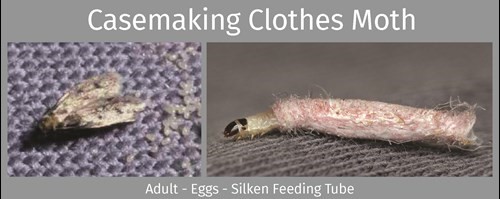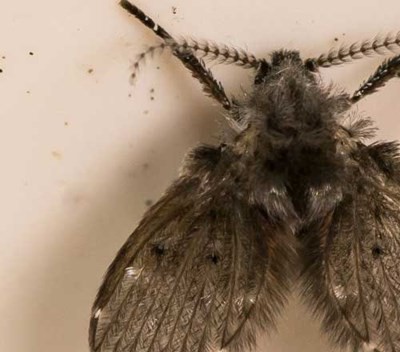With the holidays quickly approaching, and Jack Frost nipping at my heels, I was enthusiastic about swapping out my summer clothes for my favorite cozy sweaters, mittens and scarves. Snatching up the box marked “Winter Stuff” from the closet floor, I yanked out a long, cream colored cashmere scarf. Immediately, my heart sank. As with all lessons learned, this was bound to be another hard one.
In my “spring-fever” haste, I carelessly shifted my box of winter duds to the back of the closet—the dark side—where THEY fed silently, and undetected, ON MY FAVORITE SCARF! A similar encounter with a grey, wool sweater, the year before, hinted to the culprits being clothes moths. If only I had taken the time to safe-guard my clothes.
Avoid a “lesson-learned” moment. Find out how you can keep your clothes safe year-round.
What do clothes moths look like?
There are two species of clothes moths, webbing and casemaking; they are similar in size and appearance. Adults and larvae measure approximately ½ inch long. A webbing moth is goldish-tan in color; whereas, the casemaking moth has dark specks on their wings. The larva, for both species, is cream with a brown head.
Early signs of detection are: Moths, larvae, cocoons, and/or damaged clothes, rugs, etc.


What do clothes moths eat?
The moths do not eat clothes; the larva stage is when they are the most destructive. Clothes moth larvae will consume anything made from animal-based fibers, such as fur, wool, cashmere, feathers, alpaca, and even dead animals. These are the very same fibers that are often found in rugs, chairs, curtains, blankets, socks, gloves, sweaters, scarves, coats, taxidermy collections, hairballs from a pet, lint, tapestry, vintage clothing, teddy bears, and knitting yarn.
From the fibers mentioned above, webbing and casemaking larvae create feeding tubes on which they feed. Casemaking larvae will carry the tube with them, feeding from either end. Webbing larvae will spin silken tunnels over the fibers they are feeding on, forming a place where they can safely hide. These silken tubes and tunnels take on the color of the materials being consumed.
New or freshly laundered fibers are not very appetizing to clothes moths; they prefer a slightly seasoned meal—bodily fluids and spills are a plus—a soiled area rug is a smorgasbord! Larvae may also feed on the surface of soiled cotton and synthetic fabrics, causing damage to the surface area only, as they are unable to digest plant-based and synthetic fibers. However, they will feed on cotton and poly blends containing animal based fibers, leaving a holey aftermath behind.
Where do clothes moths come from?
Clothes moth eggs can inadvertently be transported into your home on new or used purchases. They can survive frigid conditions while in the egg stage, but prefer warmer climates. Be sure to look over any goods before storing them among your treasured items. Larvae can be found under folds of clothing, such as cuffs, collars, buttons, and seams.
What other types of insects feed on clothes?
Cockroaches, crickets, carpet beetles and silverfish have also been known to feast on a fiber or two. However, unlike the carpet beetle, cockroaches, crickets and silverfish do not consume the fiber; they are merely feeding off what’s on the fibers – oil, food, sweat, starch, etc. Having your clothes, carpets and furniture professionally cleaned periodically will help to reduce soil residuals.
How do I prevent clothes moths from coming inside my house?
Unfortunately, because clothes moths are active year-round, span international borders, and their eggs have been known to survive up to three years before hatching, there is not a surefire way to guarantee they won’t find a way in. However, you can lessen your chances by becoming a bit of a detective and taking a proactive approach by protecting the food sources needed for their survival—your clothes, furniture, rugs and anything else containing animal fibers.
How do I protect my clothes from clothes moths?
If the moths are already present, call a professional to assess the situation and to set up pheromone traps to track the source. Dan Stawicki, Associate Certified Entomologist and Batzner Service Operations Manager, recommends cedar lining your closet or using cedar blocks in your drawers to keep clothes moths away from items made out of animal fibers. Also, regular and thorough vacuuming is a must for reducing pet hair and fibers located under baseboards, beds, dressers, couches and return air vents.
If moths are not present, a good safeguard when storing goods is to store them in tightly sealed plastic bins, zipper bags, or vacuum sealed bags. For more tips, check out the Alternative DIY section below.

Clothes Moth Infestation: Battle Won!
Dan Stawicki’s clients had been battling a clothes moth infestation for four years. When they finally brought in professional help, the infestation had spread throughout their 7,000 square-foot home. Since clothes moths do not feed on clothes, pinpointing where the eggs resided and larvae fed was difficult (considering they hideout in dark spaces – closets, attics, boxes, etc.) However, after a few weeks, Dan had tracked them back to a box spring containing wool fibers—providing the perfect hideout spot and breeding ground.
Giving a step-by-step account of how he treated the infestation, Dan explained, “I initially set up pheromone traps to catch the adult moths and help ascertain where the infestation had originated. I then applied a liquid treatment to the baseboards, followed by a dusting to small cracks and crevices located behind woodwork and paneling. After finding larvae in the cold air returns, I also recommended to the client to have their air ducts cleaned, removing animal fiber debris that had gathered over the years.”
Dan did such a thorough job, the client’s home is now completely free of clothes moths.
Alternative DIY Solutions
- Lavender oil or dried flowers are a non-toxic, natural deterrent. However, it is not effective on larvae.
- Cedar blocks are non-toxic and a natural deterrent. When used in a sealed container, red cedar contains oils that will kill larvae.
- Deep freezing is an effective way to kill all stages of clothes moths. Seal items in a zipper bag and place in a freezer at 18°F for 12 days.
- Dry cleaning and self-laundering is also effective. When self-laundering, items should soak for 20-30 min in 120°F water.
- Moth balls have been used for years. However, there are some concerns regarding the toxic chemicals – naphthalene and paradichlorobenzene – found in moth balls. If they are used, it is recommended to make sure the container or closet they are placed in is airtight. When exposed to air, mothballs emit a gas that is suspected of causing cancer as well as other health issues.




